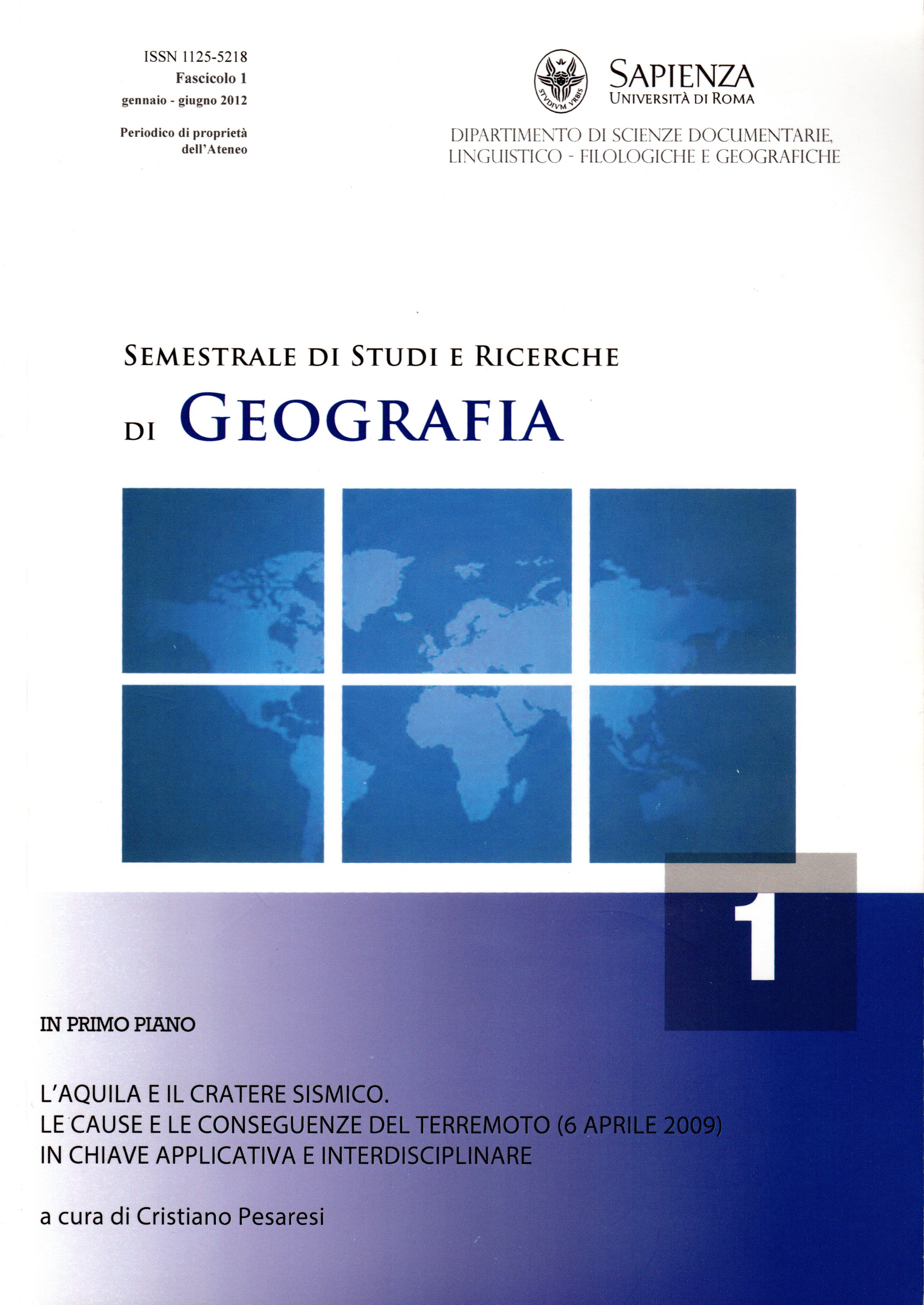Guardare oltre l’abisso e narrare il terremoto aquilano del 6 aprile 2009. Alcune notazioni critiche sull’abitare il piano C.A.S.E.
DOI:
https://doi.org/10.13133/1125-5218.15199Abstract
Beyond the abyss: giving an account of the L’Aquila earthquake of April 6, 2009. Some critical notes on living with the C.A.S.E. project
In order to carry out ethnographic research in collaboration with a community
of residents from L’Aquila, which has as its aim the enabling of service projects
in their territory, it was necessary to draw up a map of social needs and create
a cognitive mapping which would reveal the complex nature of the actual situation.
In this context, personal narratives and micro-histories of everyday life are
a key means of expanding our knowledge. This cognitive mapping restores the
creative dimension of practical experience as well as giving us the ability to devise strategies that can be put to use within the urban space, which, in the
post-earthquake period, is a combination of familiar places that have undergone
change and others that are totally unfamiliar. Also, it gives us information
about a shattered community that is having difficulty in regain in gits sense of
communality despite long term programmes devised for the purpose. Both of
these considerations allow us to observe the seismic event as it strictly relates to the history of the territory and the communities, and how it relates to the management of the territory on the part of the economic and political powers-thatbe.
Listening to the voices of the people who reside there, who live out their
lives there and who have their own ideas, means recognising in those voices a
practical proficiency that can add detailed knowledge to the political and social
debate on reconstruction, in order that the community can be dynamically empowered.
Keywords
Community, daily problems, identity, narrations, urban plan, vulnerability / resilience.
Regarder au-delà de l’abîme et narrer le tremblement de terre à L’Aquila du 6 avril 2009. Quelques notations critiques sur habiter les plan C.A.S.E.
Pour mener une enquête ethnographique en accord avec un comité citadin
aquilain, recherche qui se propose de contribuer au plan des services dans son
territoire, il a été nécessaire d’élaborer une cartographie du besoin social et une
cartographie cognitive susceptible de faire émerger la pluralité du réel. Pour attraper un tel but, les narrations du self et les micro-histoires du quotidien sont
un moyen cognitif privilégié. Cette cartographie cognitive, d’un coté, nous rend
la capacité d’élaborer des stratégies utiles pour agir dans l’espace urbain lequel,
dans la période du post-séisme, se présente composé de lieux familiaux changés et de lieux inédits. De l’autre côté, elle nous dit d’une communauté fragmentée qui cherche à se rallier avec difficulté sur le plan d’une élaboration de projets et d’une action de plus longue période. Les deux perspectives nous invitent à observer l’événement-séisme en relation serrée avec l’histoire des lieux et des communautés et avec les modalités de gestion du territoire par les pouvoirs économiques et politiques. Écouter les autobiographies de ceux qui habitent le territoire, qui y habitent et l’imaginent veut dire reconnaître dans ces voix une compétence capable d’enrichir le débat politique et social sur la reconstruction, afin d’amorcer des dynamiques d’empowerment des communautés.
Mots-clés
Communauté, identité, narrations, planification urbaine, problèmes quotidiens,
vulnérabilité/résilience.
##submission.downloads##
Pubblicato
Fascicolo
Sezione
Licenza
Gli autori che pubblicano su questa rivista accettano le seguenti condizioni:- Gli autori mantengono i diritti sulla loro opera e cedono alla rivista il diritto di prima pubblicazione dell'opera, contemporaneamente licenziata sotto una Licenza Creative Commons - Attribuzione che permette ad altri di condividere l'opera indicando la paternità intellettuale e la prima pubblicazione su questa rivista.
- Gli autori possono aderire ad altri accordi di licenza non esclusiva per la distribuzione della versione dell'opera pubblicata (es. depositarla in un archivio istituzionale o pubblicarla in una monografia), a patto di indicare che la prima pubblicazione è avvenuta su questa rivista.
- Gli autori possono diffondere la loro opera online (es. in repository istituzionali o nel loro sito web) prima e durante il processo di submission, poiché può portare a scambi produttivi e aumentare le citazioni dell'opera pubblicata (Vedi The Effect of Open Access).


